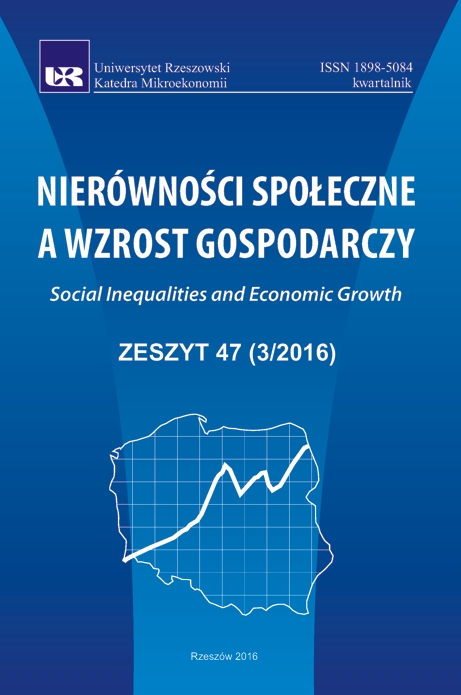Zróżnicowanie rozwojowe Polski w latach 2004–2014 na tle innych państw Unii Europejskiej – wybrane zagadnienia
DOI:
https://doi.org/10.15584/nsawg.2016.3.30Słowa kluczowe:
dysproporcje rozwojowe, Unia Europejska, PKB, finanse publiczne, innowacjeAbstrakt
Dokonujący się proces przemian ustrojowych, a następnie liberalizacja ekonomiczna oraz integracja regionalna Polski z Unią Europejską spowodowały zmianę organizacji przestrzeni społeczno-ekonomicznej oraz intensyfikację szeregu pozytywnych procesów ekonomicznych; uzależniły również sytuację polskiej gospodarki od wydarzeń na rynkach światowych, co znalazło swoje odbicie w realnej sferze gospodarki. Przy wykorzystaniu analizy porównawczej oraz deskryptyw-nej w artykule ocenie poddano zestaw wybranych parametrów ekonomicznych pozwalających odnieść się do skali i zakresu przemian, których beneficjentem stała się polska gospodarka, jak również sformułowano zalecenia dotyczące dalszych kierunków zmian. Analiza omówionych wielkości ekonomicznych prowadzi do wniosku, że UE jako jeden organizm gospodarczy jest wciąż mocno zróżnicowana. Tempo i skala dokonujących się zmian obserwowane m.in. w sferze PKB, na rynkach pracy czy w obszarze finansów publicznych nie jest zadowalające w kontekście podnoszenia konkurencyjności europejskiej gospodarki na rynkach światowych, a różnice w po-ziomie rozwoju gospodarczego państw UE sprawiają, że skala i tempo tych zmian są nierównomierne. Polska jest jedynym krajem spośród wszystkich państw UE, który przez cały okres człon-kostwa w UE nie odnotował ujemnych wartości PKB. W okresie 2008–2013 skala łącznego wzrostu PKB wyniosła 20%, co stanowi wynik najlepszy w Europie. Wśród najważniejszych czynników warunkujących utrzymanie relatywnie wysokiego tempa wzrostu gospodarczego wymienić należy w szczególności środki przekazywane Polsce w ramach funduszy unijnych, bezpośrednie inwestycje zagraniczne oraz prywatne transfery pieniężne.Downloads
Download data is not yet available.
Pobrania
Opublikowane
2020-11-11
Jak cytować
Gasz, M. (2020). Zróżnicowanie rozwojowe Polski w latach 2004–2014 na tle innych państw Unii Europejskiej – wybrane zagadnienia. Nierówności Społeczne a Wzrost Gospodarczy, 3(47), 415–426. https://doi.org/10.15584/nsawg.2016.3.30
Numer
Dział
Artykuły
Licencja
Prawa autorskie (c) 2016 Uniwersytet Rzeszowski

Utwór dostępny jest na licencji Creative Commons Uznanie autorstwa – Na tych samych warunkach 4.0 Miedzynarodowe.


